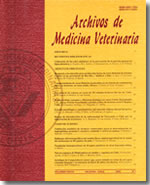Stillborn piglets: anatomopathological characterization and immunoserological studies in three intensive management farms
Main Article Content
Abstract
The purposes of this study was to characterize the stillborn piglets, based on gross pathological findings, and to determine the presence of potentially related infectious agents using immunoserological tests of pleural fluid. The study was conducted in three "in doors" farms (A, B, and C) with intensive management, in Buenos Aires Province, Argentina. In total 1.024 stillbirths were classified in antepartum (mommified or non-mommified) and intrapartum. Two hundred randomly selected samples of pleural fluid were processed for detection of antibodies to porcine parvovirus, Aujeszky's disease virus, Leptospira interrogans (4 serogroups) and Brucella suis. Antibodies to Toxoplasma gondii were studied in 738 samples. The stillbirths in farms A, B, and C were 4.1 , 3.4 , and 10.8%, respectively, with variable numbers for the three different types. In farms A and C the intrapartum type reached the highest percentages (61.8 and 92.2), while farm B presented the highest mummy rate (54.8). For farms A and C values were associated with Leptospira interrogans serogroup Icterohemorrhagiae antibodies and the ones in farm B with parvovirus antibodies. Antibodies to Toxoplasma gondii were detected in the three farms, and the high rate in farm B was related to abundant cat population. All samples were negative for Brucella suis and Aujeszky's disease virus. According to the results, it can be concluded that characterization of stillbirths, in association with immunoserological studies of pleural fluid is a simple and effective method that can contribute to the knowledge about the exposure of breeding stocks to reproductive pathogens.

